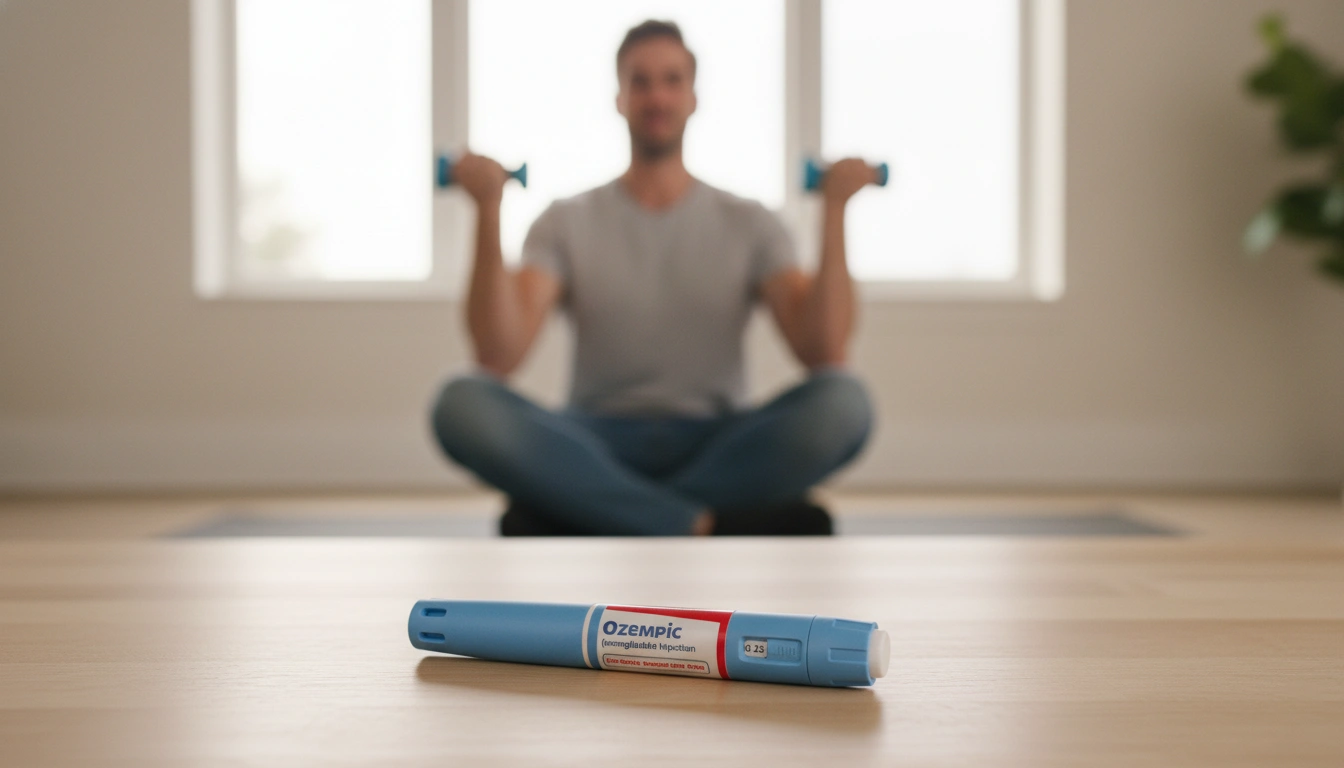Navigating Diabetes Management: Can Ozempic and Glipizide Be Taken Together?

Introduction
Managing type 2 diabetes often involves a personalized approach, integrating various medications, lifestyle adjustments, and consistent monitoring. It’s a journey that demands attention to detail, especially when considering the combination of different pharmacological agents. Many individuals find themselves balancing multiple prescriptions, each designed to address specific aspects of their health. One common question that arises in this complex landscape is whether it’s safe and effective to combine a GLP-1 receptor agonist like Ozempic® with a sulfonylurea such as glipizide. This question is particularly pertinent because both medications are highly effective in lowering blood sugar, but their combined effect could potentially lead to significant interactions if not managed meticulously.
This post will delve into the intricacies of taking Ozempic® and glipizide concurrently, exploring their individual mechanisms of action, the potential risks involved, and the crucial considerations for healthcare providers and patients alike. We understand that navigating medication decisions can be overwhelming, which is why we’re dedicated to providing clear, authoritative information rooted in medical science. Our purpose here at TrimRx is to illuminate the potential benefits and challenges of this specific medication combination, empowering you with the knowledge needed to engage effectively with your healthcare team. We believe that sustainable health management, especially concerning complex conditions like diabetes, is achieved through science, empathy, and a transparent approach. By the end of this article, you will have a comprehensive understanding of what to consider if your treatment plan involves both Ozempic® and glipizide, and how a personalized, medically supervised approach can help ensure your safety and well-being.
Understanding Type 2 Diabetes Management
Type 2 diabetes is a chronic condition characterized by the body’s inability to effectively use insulin (insulin resistance) or to produce enough insulin, leading to elevated blood glucose levels. If left unmanaged, these high blood sugar levels can lead to serious health complications affecting the heart, kidneys, nerves, and eyes. Effective management typically involves a multi-pronged strategy that includes dietary changes, regular physical activity, and often, medication. The goal is to maintain blood glucose levels within a target range, thereby preventing or delaying these long-term complications.
Historically, diabetes management has evolved significantly. From early dietary interventions to the discovery of insulin, and more recently, the development of a wide array of oral and injectable medications, the tools available have become increasingly sophisticated. Each class of medication works through different mechanisms, offering healthcare providers a diverse toolkit to tailor treatment to individual patient needs. At TrimRx, we recognize that every individual’s journey is unique, and our approach combines advanced medical science with modern technology to offer compassionate care and truly personalized solutions for healthier living.
The Role of Different Medication Classes
Various medications play distinct roles in the complex symphony of diabetes treatment. Understanding these roles is crucial when considering how different drugs might interact.
Sulfonylureas: Glipizide’s Mechanism
Glipizide belongs to a class of drugs called sulfonylureas. These medications work primarily by stimulating the beta cells in the pancreas to release more insulin. This increased insulin helps the body absorb glucose from the bloodstream, thereby lowering blood sugar levels. Glipizide is typically taken orally and has been a cornerstone of type 2 diabetes treatment for decades due to its effectiveness in reducing hyperglycemia.
While effective, sulfonylureas come with their own set of considerations. Because they directly stimulate insulin release, they can sometimes lead to hypoglycemia, or low blood sugar, especially if meals are skipped or physical activity is increased without adjusting medication. This direct action on insulin secretion is a key point when discussing interactions with other glucose-lowering agents.
GLP-1 Receptor Agonists: Ozempic®’s Approach
Ozempic® (semaglutide) is a glucagon-like peptide-1 (GLP-1) receptor agonist. Unlike sulfonylureas, Ozempic® works through multiple pathways to improve blood sugar control. First, it enhances glucose-dependent insulin secretion, meaning it stimulates insulin release only when blood sugar levels are high, reducing the risk of hypoglycemia compared to sulfonylureas when used alone. Second, it suppresses glucagon secretion from the pancreas, which prevents the liver from releasing excessive stored sugar. Third, Ozempic® slows gastric emptying, leading to a feeling of fullness and reduced food intake, which can contribute to weight loss—a significant benefit for many individuals with type 2 diabetes. Ozempic® is an FDA-approved medication for lowering blood sugar in adults with type 2 diabetes and for reducing the risk of major cardiovascular events in adults with type 2 diabetes and established heart disease. It is administered via subcutaneous injection.
Our personalized weight loss programs offer branded medications like Ozempic®, along with other options like compounded Semaglutide and Tirzepatide, all provided through FDA-registered and inspected pharmacies. To explore if these solutions are right for you, we encourage you to take our free assessment quiz.
The Interaction: Ozempic® and Glipizide
The primary concern when combining Ozempic® and glipizide is the increased risk of hypoglycemia. Both medications are designed to lower blood glucose, but they do so through different mechanisms. When used together, their combined effect can significantly reduce blood sugar levels, potentially to dangerously low points.
Understanding Hypoglycemia
Hypoglycemia, or low blood sugar (typically below 70 mg/dL), is a condition that requires immediate attention. Symptoms can include headache, dizziness, drowsiness, nervousness, confusion, tremor, nausea, hunger, weakness, perspiration, palpitations, and rapid heartbeat. In severe cases, it can lead to seizures, unconsciousness, and even death. It is crucial for anyone taking glucose-lowering medications to be aware of these symptoms and know how to respond. Often, consuming fast-acting carbohydrates (like glucose tablets, fruit juice, or hard candies) can quickly raise blood sugar.
When Ozempic® and glipizide are prescribed together, the potential for hypoglycemia becomes a central focus for patient safety. While Ozempic® is less likely to cause hypoglycemia on its own due to its glucose-dependent action, combining it with a sulfonylurea like glipizide, which continuously stimulates insulin release, elevates this risk considerably.
Clinical Considerations for Combination Therapy
Despite the increased risk of hypoglycemia, there may be clinical situations where a healthcare provider determines that the combined use of Ozempic® and glipizide is necessary. This typically occurs when an individual’s blood sugar levels remain inadequately controlled despite optimal dosing of one medication or when a more aggressive approach is needed to achieve glycemic targets. In such cases, the benefits of achieving better blood sugar control might outweigh the risks, provided that stringent monitoring and patient education are in place.
Dose Adjustments and Monitoring
If a healthcare provider decides to prescribe both Ozempic® and glipizide, a key strategy to mitigate hypoglycemia risk is careful dose adjustment. Often, the dose of glipizide will be reduced when Ozempic® is initiated or increased. This proactive measure aims to prevent an excessive drop in blood sugar.
Frequent monitoring of blood glucose levels is paramount. This may involve more frequent self-monitoring by the patient throughout the day, including before and after meals and at bedtime. Continuous Glucose Monitoring (CGM) systems can also be invaluable tools for tracking blood sugar trends and identifying potential hypoglycemic episodes. Patients must be diligently monitoring their glucose levels throughout the day and be able to recognize the symptoms of low blood sugar. This diligent approach is a testament to the personalized, medically supervised care that we champion at TrimRx. Our programs are designed to provide the necessary support and guidance, including comprehensive service that includes doctor consultations, medication, lab work, unlimited support, and shipping, to ensure your safety and treatment effectiveness.
Patient Education and Communication
Open and honest communication between the patient and their healthcare provider is critical. Patients should be thoroughly educated on the signs and symptoms of hypoglycemia, how to treat it, and when to seek emergency medical attention. They should also be instructed on how to adjust their diet and activity levels in response to blood sugar readings, and how to carry fast-acting carbohydrates with them at all times.
It is important to tell your doctor about all other medications you use, including vitamins and herbs. Do not stop using any medications without first talking to your doctor. This commitment to transparent service and patient empowerment is a core tenet of our philosophy at TrimRx, ensuring our approach remains consistent regardless of dosage changes.
Other Important Drug and Lifestyle Interactions
Beyond the direct interaction between Ozempic® and glipizide, other factors can influence blood glucose levels and medication efficacy. These considerations highlight the holistic nature of diabetes management.
Alcohol Consumption
Alcohol can significantly affect blood glucose levels in individuals with diabetes, potentially causing both hypoglycemia and hyperglycemia, depending on the quantity and frequency of consumption. Drinking alcohol on an empty stomach or after exercise can increase the risk of hypoglycemia. If your diabetes is not well-controlled, or if you have high triglycerides, neuropathy, or pancreatitis, avoiding alcohol altogether might be recommended.
For those with controlled diabetes, moderate alcohol intake (typically defined as one drink daily for women and two for men) in conjunction with a normal meal plan may be acceptable, but it’s essential to discuss this with a healthcare provider. Alcohol can also interact with other diabetes medications, such as metformin (often co-prescribed with glipizide), increasing the risk of lactic acidosis. This reinforces the need for comprehensive medical supervision and transparency about all lifestyle choices during your weight loss journey.
Food and Oral Semaglutide Absorption
For oral semaglutide formulations (different from the injectable Ozempic® but belonging to the same drug class), food and beverage interactions are particularly important for absorption. It is generally recommended that oral semaglutide be taken with no more than 4 ounces of plain water, 30 minutes before the first food, beverage, or other oral medications of the day. Fasting for longer than 30 minutes after taking the dose may lead to more side effects such as nausea, vomiting, and diarrhea. While this instruction applies specifically to oral semaglutide, it underscores the sensitivity of GLP-1 medications to dietary factors and the importance of adhering to precise administration guidelines.
Our personalized programs include various options, from branded Ozempic® to compounded oral semaglutide, and our healthcare team provides clear guidance on how to take your medications for optimal effectiveness and safety. To discover which of these options might be suitable for your needs, we invite you to take our free assessment quiz.
Broader Considerations for Ozempic® Use
While our focus has been on the interaction with glipizide, it’s beneficial to briefly consider other aspects of Ozempic® use for a more complete picture.
Common and Serious Side Effects of Ozempic®
Like all medications, Ozempic® comes with potential side effects. Common side effects often include nausea, vomiting, diarrhea, constipation, and stomach pain. These are usually mild and tend to improve over time. However, if they are severe or persistent, it’s crucial to inform your healthcare provider.
More serious, though less common, side effects warrant immediate medical attention. These include severe allergic reactions (breathing problems, swelling of face/throat, rash), pancreatitis (severe stomach pain radiating to the back, with or without vomiting), thyroid tumors (lump in the neck, trouble swallowing, hoarseness), vision changes (especially worsening diabetic retinopathy), kidney damage (reduced urination, swelling, weakness, confusion), severe stomach problems (gastroparesis-like symptoms), and gallbladder issues (fever, jaundice, upper stomach pain, clay-colored stools).
Our commitment to safety means we work exclusively with FDA-registered and inspected pharmacies for the shipping of weight loss medications. We believe in providing compassionate care that respects every individual’s unique journey, combining advanced medical science with modern technology.
Contraindications and Precautions
Ozempic® should not be used by individuals with a personal or family history of medullary thyroid carcinoma (MTC) or Multiple Endocrine Neoplasia syndrome type 2 (MEN 2), due to the risk of thyroid tumors. It is also contraindicated in individuals with known allergies to semaglutide or any other ingredients in the product.
Patients with a history of pancreatitis, kidney problems, or diabetic retinopathy should discuss these conditions thoroughly with their healthcare provider before starting Ozempic®, as these may require closer monitoring or alternative treatments. Additionally, since Ozempic® slows gastric emptying, it’s important to inform your healthcare provider about its use if you have an upcoming surgery or procedure that requires anesthesia, as it might increase the risk of aspiration.
The TrimRx Approach to Personalized Weight Loss
At TrimRx, our journey began with a shared vision to help individuals embrace healthier lifestyles by merging cutting-edge telehealth innovations with effective weight loss solutions. We understand that effective diabetes management often goes hand-in-hand with weight management. Our platform is a user-friendly and supportive space where individuals receive personalized, medically supervised care—all designed to make sustainable weight loss attainable and tailored to the individual. We believe that sustainable weight loss should be achieved through science, empathy, and a transparent approach.
Our brand is empathetic, innovative, trustworthy, supportive, results-oriented, and personalized. We offer compassionate care that respects every individual’s unique journey by combining advanced medical science with modern technology. Our commitment to transparent service means our approach remains consistent, and our focus on safety is paramount, working exclusively with FDA-registered and inspected pharmacies.
Personalized Weight Loss Programs
For individuals considering prescription weight loss medications like Ozempic® or its alternatives, our Personalized Weight Loss Program is designed to provide comprehensive support. This program includes:
- Doctor Consultations: To assess eligibility, discuss medical history, and create a tailored treatment plan.
- Medication: Including FDA-approved branded options such as Ozempic®, Mounjaro®, Zepbound®, and Wegovy®, as well as carefully selected compounded medications like Compounded Semaglutide, Oral Semaglutide, Compounded Tirzepatide, and Oral Tirzepatide, all provided through FDA-registered, inspected, and approved pharmacies. We ensure clarity that while branded medications have FDA approval, compounded medications are not FDA approved.
- Lab Work: To monitor health markers and ensure treatment suitability.
- Unlimited Support: Our team is here for you every step of the way.
- Shipping: Medications are conveniently shipped directly to you from our partner pharmacies, with no hidden fees.
To determine if you qualify for our prescription weight loss medications and receive a personalized treatment plan, we invite you to take our free assessment quiz. This quiz is the first step toward a healthier you, allowing us to understand your unique needs and goals.
Quick-Access Supplements for Holistic Support
In addition to our personalized prescription programs, we offer quick-access supplements that do not require a quiz, designed to support overall wellness during your weight loss journey. These supplements are available for immediate purchase:
- GLP-1 Daily Support: This supplement is formulated to complement your wellness efforts, providing daily support for your metabolic health.
- Weight Loss Boost: Designed to give you an extra edge, this boost can help optimize your body’s natural processes for weight management.
These supplements reflect our commitment to providing a full spectrum of options to support your health and weight loss goals, whether you’re managing diabetes, aiming for sustainable weight loss, or both. We are here to partner with you in health, offering solutions that are safe, effective, and tailored to your individual needs.
Conclusion
The question of whether Ozempic® and glipizide can be taken together is complex, underscoring the nuanced nature of managing type 2 diabetes. While both medications are highly effective in lowering blood sugar, their combined use significantly increases the risk of hypoglycemia. This interaction necessitates a careful, medically supervised approach, involving precise dose adjustments, frequent blood glucose monitoring, and comprehensive patient education. It is never advisable to make changes to your medication regimen without the explicit guidance of your healthcare provider.
Our mission at TrimRx is to provide medically supervised, personalized weight loss solutions that prioritize safety and efficacy. We stand by our commitment to transparent service and compassionate care, guiding individuals through their health journeys with the latest scientific advancements and unwavering support. Whether you are navigating the complexities of medication interactions, seeking sustainable weight loss, or striving for overall well-being, we are here to help.
Remember, your health journey is personal, and a tailored approach is often the most effective. If you are considering options for diabetes management or weight loss, we encourage you to consult with a healthcare professional to understand your best path forward. To see if our personalized programs with prescription medications are right for you, don’t hesitate to take our free assessment quiz today. For immediate support for your wellness goals, explore our GLP-1 Daily Support and Weight Loss Boost supplements. Together, we can work towards a healthier, more vibrant future.
Frequently Asked Questions
Q1: Is it safe to take Ozempic® and glipizide at the same time?
While it is possible for Ozempic® and glipizide to be prescribed together, this combination significantly increases the risk of hypoglycemia (low blood sugar). Your healthcare provider would need to carefully manage dosages, likely reducing the glipizide dose, and require very frequent blood sugar monitoring to ensure your safety. It is crucial to always follow your doctor’s instructions and never adjust your medications without their guidance.
Q2: What are the symptoms of low blood sugar (hypoglycemia) that I should look out for if I am taking both medications?
Symptoms of hypoglycemia can include headache, dizziness, drowsiness, nervousness, confusion, tremor, nausea, extreme hunger, weakness, sweating, palpitations, and a rapid heartbeat. If you experience any of these symptoms, it’s important to act quickly by consuming a fast-acting carbohydrate source (e.g., glucose tablets, fruit juice) and inform your healthcare provider.
Q3: How does TrimRx support individuals managing complex medication regimens like Ozempic® and glipizide?
At TrimRx, we prioritize personalized, medically supervised care. Our comprehensive service for prescription weight loss programs includes doctor consultations to assess your specific needs, manage potential drug interactions, and tailor your treatment plan. We provide ongoing support, lab work, and medication shipped from FDA-registered pharmacies. Our goal is to ensure your safety and treatment effectiveness while offering empathetic and transparent care. To learn more about our personalized programs and see if you qualify, you can take our free assessment quiz.
Q4: Are there other lifestyle factors that can influence the interaction between Ozempic® and glipizide?
Yes, lifestyle factors such as alcohol consumption and meal timing can significantly impact blood glucose levels and the effectiveness of your medications. Alcohol can cause both low and high blood sugar, and specific timing for taking oral semaglutide (if prescribed) relative to meals is crucial for its absorption. Always discuss your diet, exercise routine, and alcohol intake with your healthcare provider to ensure your treatment plan remains safe and effective. Additionally, our quick-access supplements like GLP-1 Daily Support and Weight Loss Boost can support overall wellness during your journey.

Transforming Lives, One Step at a Time
Keep reading
Navigating Your Treatment: How Many Pens in an Ozempic Box and What It Means for Your Health Journey
Curious how many pens in an Ozempic box? Our guide breaks down Ozempic pen strengths, doses, and how TrimRx supports your weight management journey. Click to learn more!
Empowering Your Health: A Comprehensive Guide on How to Use Ozempic Pens Effectively
Learn how to use Ozempic pens safely and effectively with our step-by-step guide. Master preparation, injection, & disposal for your weight management journey. Get expert tips!
Understanding Your Ozempic Pen: How to Tell When It’s Empty
Wondering how do I know when my Ozempic pen is empty? Learn key indicators, the dose counter trick, and proactive tips for consistent dosing.



